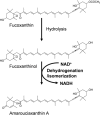Absorption and metabolism of xanthophylls
- PMID: 21747746
- PMCID: PMC3131559
- DOI: 10.3390/md9061024
Absorption and metabolism of xanthophylls
Abstract
Dietary carotenoids, especially xanthophylls, have attracted significant attention because of their characteristic biological activities, including anti-allergic, anti-cancer, and anti-obese actions. Although no less than forty carotenoids are ingested under usual dietary habits, only six carotenoids and their metabolites have been found in human tissues, suggesting selectivity in the intestinal absorption of carotenoids. Recently, facilitated diffusion in addition to simple diffusion has been reported to mediate the intestinal absorption of carotenoids in mammals. The selective absorption of carotenoids may be caused by uptake to the intestinal epithelia by the facilitated diffusion and an unknown excretion to intestinal lumen. It is well known that β-carotene can be metabolized to vitamin A after intestinal absorption of carotenoids, but little is known about the metabolic transformation of non provitamin A xanthophylls. The enzymatic oxidation of the secondary hydroxyl group leading to keto-carotenoids would occur as a common pathway of xanthophyll metabolism in mammals. This paper reviews the absorption and metabolism of xanthophylls by introducing recent advances in this field.
Keywords: absorption; bioavailability; carotenoid; metabolism; xanthophyll.
Figures




References
-
- Miller NJ, Sampson J, Candeias LP, Bramley PM, Rice-Evans CA. Antioxidant activities of carotenes and xanthophylls. FEBS Lett. 1996;384:240–242. - PubMed
-
- Di Mascio P, Kaiser S, Sies H. Lycopene as the most efficient biological carotenoid singlet oxygen quencher. Arch Biochem Biophys. 1989;274:532–538. - PubMed
-
- Junghans A, Sies H, Stahl W. Macular pigments lutein and zeaxanthin as blue light filters studied in liposomes. Arch Biochem Biophys. 2001;391:160–164. - PubMed
-
- Katsuura S, Imamura T, Bando N, Yamanishi R. Beta-carotene and beta-cryptoxanthin but not lutein evoke redox and immune changes in RAW264 murine macrophages. Mol Nutr Food Res. 2009;53:1396–1405. - PubMed
-
- Yamaguchi M, Weitzmann MN. The bone anabolic carotenoid beta-cryptoxanthin enhances transforming growth factor-beta1-induced SMAD activation in MC3T3 preosteoblasts. Int J Mol Med. 2009;24:671–675. - PubMed
Publication types
MeSH terms
Substances
LinkOut - more resources
Full Text Sources

